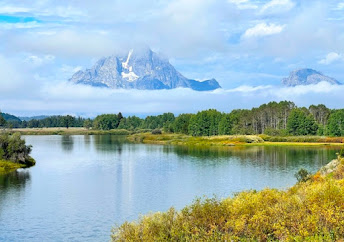Wide angle view of the Teton Range
When you visit a place
as stunningly beautiful as Grand Teton National Park, you run the risk of
having bad weather, which means you really aren’t able to see and absorb the
magnificence of God’s handiwork. Even an overcast, foggy day could obscure the
wonder of the landscape.
Actually that happened
as we first drove through Grand Teton on our way to Yellowstone National Park
last month. It wasn’t raining or snowing, but the weather was off just enough
to dampen our appreciation of the scenery.Clouds obscure most of the mountains.
However, we returned to
Grand Teton after five days in Yellowstone. The Teton Mountain Range rises
abruptly from the Jackson Hole valley. Although the rocks at the core of the
mountains are some of the oldest in North American, the mountain range itself
is among the youngest in the world. First the Teton fault lifted the range,
then massive glaciers carved peaks and canyons and created beautiful lakes. The
Tetons continue to change from natural forces like erosion.Moran Mountain shines in this reflection photo.
On our final day in the
park, not only was the sun shining, but the sky was filled with fluffy, white
clouds, and water in the lakes was clear and calm. I literally jumped for joy.
This was what we had hoped for. Conditions were perfect for the best reflection
photos of this trip.
I hope these photos will inspire you to visit and to explore this remarkable park.

















1 comment:
Spent a week in West Yellowstone and Island Park, ID in September and the Tetons were almost always on the horizon. https://bitesflightsandsights.com/fly-fishing-in-northeastern-idaho-bites/
Post a Comment